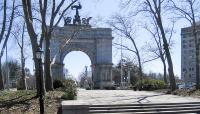Landscape Information
First envisioned in 1865, the plaza was conceived as the primary entrance for Olmsted and Vaux’s 526-acre Prospect Park. The elliptical plaza capped the park’s northern tip with a paved, pedestrian area ringed by carriageways and heavily-planted crescent-shaped berms. Initially the plaza featured a statue of Abraham Lincoln and a central fountain, both dwarfed by its huge open expanse. The inner oval changed dramatically in the wave of Neoclassicism that swept the city in the early 1890s. In 1889 John H. Duncan’s Memorial Arch and columns were begun, along with entrance pavilions and features by McKim, Mead and White and statuary by Frederick MacMonnies. Lincoln’s statue was moved to the park’s interior, and by 1895, the plaza had been transformed, including a new electric fountain at its center surrounded by a simple lawn. Grand Army Plaza retains the original planted berms and later neoclassical elements, all intact within a greatly-expanded interior traffic circle. A final version of the fountain by sculptor Eugene F. Savage, created in 1931, sits at the oval’s center; the lawn is now filled with trees. Memorial Arch and Prospect Park are New York City landmarks and Grand Army Plaza was named a National Historic Landmark in 1975.
















